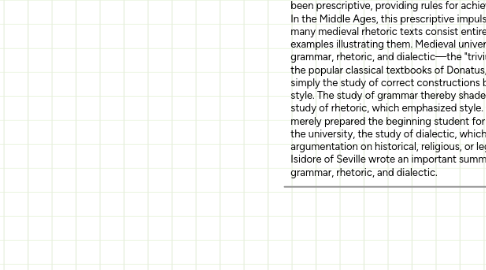
1. . The study of rhetoric was manifested, however, in techniques for adult practitioners, for example, in ars dictaminis, the art of composing official letters through which church and state business was conducted, and ars praedicandi, the art of preaching. Medieval theorists of poetry also drew on rhetorical studies of style.
1.1. In the early Renaissance, major texts by Cicero and Quintilian were recovered. In the sixteenth century, a proliferation of rhetorics following classical models but written in the vernacular appeared, such as those in English by Leonard Cox, Richard Sherry, Thomas Wilson, and George Puttenham. Most of these rhetoricians emphasized the study of style, sometimes linking their practice explicitly with poetic. The generally acknowledged master of stylistic rhetoric in the Renaissance was Erasmus, whose Copia (1512) [56] was originally conceived as a textbook.
1.1.1. Another source of change for Renaissance rhetoric was the influential work of Peter Ramus (Pierre de la RamŽe), whose ideas were recorded in Institutiones Oratoriae (1545) by his colleague Talaeus (Omer Talon). Ramus wished to reform the medieval trivium by reemphasizing the classical division of the stages of composing. Ramist rhetoric intensifies the separation between these stages and the importance of their sequence, at the same time divorcing invention and arrangement from rhetoric and assigning them to logic. Ramists hoped to define a logical, scientific discourse, untainted by nonlogical appeals, that would win assent from the rational audience by virtue of rationality alone. Ramus's fellow Puritans widely adopted this plain style for all serious matters.
1.1.1.1. Renaissance hermetic precursors of modern science, and delivery would give rise in the eighteenth century to elaborate elocutionary techniques for public speakers and actors. Still, memory and delivery tended to continue their decline in importance as the Renaissance dissemination of printing made written texts ever more important to academic, religious, and political life. Rhetoricians, then, came increasingly to focus upon the study of language as the dress of ideas that were generated elsewhere. The goal of rhetorical study was to clothe one's ideas in the most elegant dress possible, and rhetoric thus came to be seen as the finishing refinement of an upper-class education.
1.1.1.1.1. Rhetoricians from the University of Edinburgh sought to stop this trend by arguing that the study of correct and persuasive style produced not only competent public speakers but virtuous people. This was a strong defense, for the study of rhetoric in American colleges focused on oratory that would be useful to clergy, lawyers, and politicians. In addition, the Edinburgh rhetoricians connected the study of persuasion with the more prestigious scientific discipline of psychology.
2. Rhetoric & Composition
2.1. The formal study of rhetoric in the West began in Greece in the fifth century B.C.E. with the Sophists [42], followed by Isocrates [44], Plato [45], and Aristotle [46].
2.1.1. The main line of Greek rhetoric was extended by Roman rhetoricians, notably Cicero [47, 49] and Quintilian [51, 52].
2.1.1.1. . But it is more accurate to see medieval rhetoricians selecting and reshaping the classical heritage in light of Augustine's reinterpretation of rhetoric to suit Christian purposes [53]. The goal became saving souls, not leading the state. Another important emphasis was the desire to codify authoritative classical precepts on good composition. Classical rhetoric texts had often been prescriptive, providing rules for achieving effective speeches. In the Middle Ages, this prescriptive impulse so intensified that many medieval rhetoric texts consist entirely of lists of rules and examples illustrating them. Medieval university students studied grammar, rhetoric, and dialectic—the "trivium." As exemplified in the popular classical textbooks of Donatus, grammar means not simply the study of correct constructions but also the analysis of style. The study of grammar thereby shaded over into the medieval study of rhetoric, which emphasized style. Grammar and rhetoric merely prepared the beginning student for the serious business of the university, the study of dialectic, which offered practice in oral argumentation on historical, religious, or legal issues. Bishop Isidore of Seville wrote an important summary of the arts of grammar, rhetoric, and dialectic.
3. Adult Education
3.1. 1727 The Junto established by Benjamin Franklin – First called the 'Leather Apron', this is a secularization of the Puritan divine Cotton Mather's idea (1710) of a discussion club. The original rules would still be regarded as good guidelines for discussion.
3.1.1. 1826 The first lyceum at Millbury, Mass. Organized by Josiah Holbrook – The first step in a national lyceum movement involving the organization of local study groups. Generally credited with anticipating the development of later 'home study' programs, the introduction of the lecture-forum method, as well on the action side as being greatly influential in creating popular support for establishing the public school system.
3.1.1.1. 1833 The first tax supported library at Peterborough N. H.
3.1.1.1.1. New no1862 Two events: the beginning of the U. S. Department of Agriculture and The Land Grant Act (The Morrill Act) – These are the strategic items of federal legislation that initiated the institutional structure for the later emergence of the Cooperative Extension System in 1914 (Smith Lever Act)de
